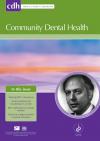Community Dental Health

- Cover Date:
- September 2016
- Print ISSN:
- 0265 539X
- Vol:
- 33
- Issue:
- 3
Development of life story experience (LSE) scales for migrant dentists in Australia: a sequential qualitative-quantitative study
Introduction: The integration of qualitative and quantitative approaches introduces new avenues to bridge strengths, and address weaknesses of both methods. Objective: To develop measure(s) for migrant dentist experiences in Australia through a mixed methods approach. Methods: The sequential qualitative-quantitative design involved first the harvesting of data items from qualitative study, followed by a national survey of migrant dentists in Australia. Statements representing unique experiences in migrant dentists’ life stories were deployed the survey questionnaire, using a five-point Likert scale. Factor analysis was used to examine component factors. Results: Eighty-two statements from 51 participants were harvested from the qualitative analysis. A total of 1,022 of 1,977 migrant dentists (response rate 54.5%) returned completed questionnaires. Factor analysis supported an initial eight-factor solution; further scale development and reliability analysis led to five scales with a final list of 38 life story experience (LSE) items. Three scales were based on home country events: health system and general lifestyle concerns (LSE1; 10 items), society and culture (LSE4; 4 items) and career development (LSE5; 4 items). Two scales included migrant experiences in Australia: appreciation towards Australian way of life (LSE2; 13 items) and settlement concerns (LSE3; 7 items). Conclusion: The five life story experience scales provided necessary conceptual clarity and empirical grounding to explore migrant dentist experiences in Australia. Being based on original migrant dentist narrations, these scales have the potential to offer in-depth insights for policy makers and support future research on dentist migration.
Key words: dentists, human migration, methodology, life story experience scales, Australia
doi:10.1922/CDH_3842Balasubramanian07
- Article Price
- £15.00
- Institution Article Price
- £
- Page Start
- 225
- Page End
- 231
- Authors
- M. Balasubramanian, A.J. Spencer, S.D. Short, K. Watkins, S. Chrisopoulos, D.S. Brennan
Articles from this issue
- Title
- Pg. Start
- Pg. End
- Challenges identified in a pilot outreach dental service for Traveller children in Hackney, East London
- 185
- 188
- Understanding avoidance and non-attendance among adolescents in dental care - an integrative review
- 195
- 207
- Variations in survival time for amalgam and resin composite restorations: a population based cohort analysis
- 208
- 212
- Impact of providing free preventive dental products without health workers’ counselling on infants’ tooth-brushing and bottle-feeding termination practices: a randomised controlled trial
- 213
- 217
- The dental public health implications of cosmetic dentistry: a scoping review of the literature
- 218
- 224
- Development of life story experience (LSE) scales for migrant dentists in Australia: a sequential qualitative-quantitative study
- 225
- 231
